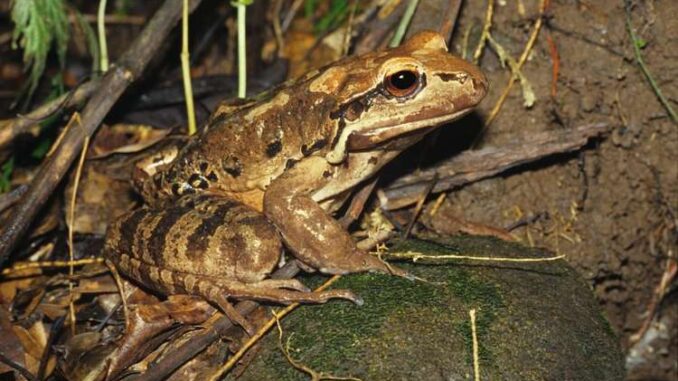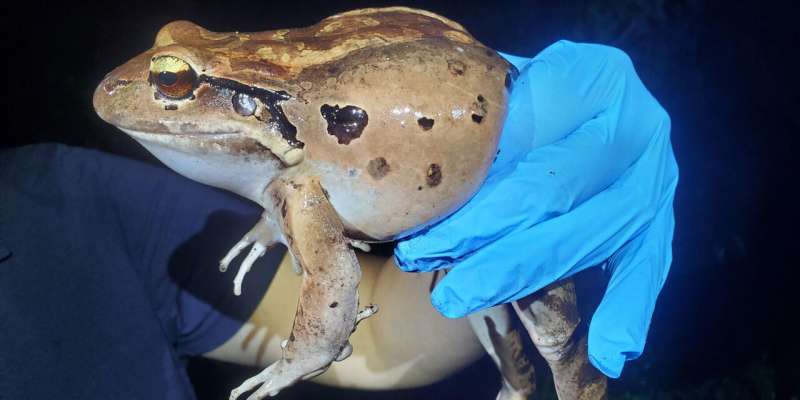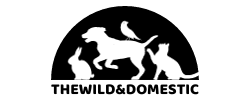
[ad_1]
A rescue mission is under way in the Caribbean to save one of the world’s largest—and rarest—frogs from extinction.
Measuring as much as 20 centimeters from snout to rear and weighing up to a kilo, the mountain chicken—named for its reputedly tasty flesh—is a frog in freefall. And, these days, hunting for its meat is the least of its problems.
Once found on at least five major islands in the Lesser Antilles, this giant frog is now confined to Dominica—where it once had the misfortune to be the unofficial national dish—and to a small enclosed area on the nearby island of Montserrat.
Putting the mountain chicken on the map
The mountain chicken has been on Fauna & Flora’s radar before. During the volcanic eruptions that began on Montserrat in 1995, and which later destroyed the capital and forced two-thirds of the population to flee, we carried out emergency surveys to assess the impact on this culturally important amphibian. This was the first time that the frog’s plight was drawn to the attention of the wider world.
Croak of invisibility
The devastating fungal disease chytridiomycosis reached Montserrat in 2009, prompting the decision to evacuate as many healthy frogs as possible and conserve the species through captive-breeding programs in zoos.
Without the earlier intervention in 1995, there seems little doubt that the entire mountain chicken population on Montserrat would have succumbed, out of sight and out of mind. Unfortunately, efforts to repatriate the zoo-bred frogs have been complicated by their lack of resistance to disease.
On Dominica, meanwhile, where the critically endangered frog is known as kwapo (derived from “crapaud,” the French word for toad) in the local Kwéyòl dialect, the deadly chytrid fungus has continued to take a heavy toll since it was first recorded on the island in 2002.
Less than two years after first being detected, the disease had wiped out an estimated 80% of Dominica’s entire mountain chicken population.
Fears that the species was extinct on the island by 2008 proved unfounded, but a frog that was once abundant enough to be harvested for food has been reduced to perilously low numbers.
Just how perilously low was uncertain, until now.

We’re all going on a frog hunt
Fauna & Flora was one of the many local, regional and international organizations that recently leapt into action to support a comprehensive month-long survey on Dominica, covering the mountain chicken’s traditional strongholds on the island.
The mission to save the mountain chicken is a highly collaborative affair involving a list of contributors and funders longer than the legs of the beleaguered frog that Fauna & Flora and its partners are working to rescue. This latest survey was five months in the planning. Almost 30 conservationists from 13 different organizations came together to form the multinational team, which spent a combined total of 960 hours in the field spread across 26 nights searching for the super-rare amphibian.
How many mountain chickens are left?
Working from dusk to dawn, the frog seekers braved steep terrain and treacherous riverbeds in their quest to find the world’s last remaining wild mountain chickens. Worryingly, their combined efforts succeeded in recording just 23 frogs, including two road casualties. More encouragingly, they did encounter two juveniles and five froglets, indicating that the species is still breeding.
The team also believes that the weather at one of the survey locations may have been a factor in the low number recorded there, because the extremely dry conditions meant that the frogs weren’t calling (typically, their barks can be heard almost a mile away) and couldn’t therefore be pinpointed using sound.

A ray of hope
Arguably the most uplifting moment was the rediscovery of a familiar frog that had been recorded years earlier. Still alive and kicking despite everything that has been thrown at him during the intervening period, this slippery survivor is at least 11 years old and officially the oldest mountain chicken on record.
Which begs the question: how has this particular individual escaped the clutches of the chytrid tsunami that has been sweeping across the country for two decades? Is he the world’s most fortunate frog, or has he somehow acquired resistance to the lethal effects of the fungus? Analysis of the genetic samples taken from all the captured frogs may provide further clues.
Has the mountain chicken run out of time?
The most recent previous estimates had put the surviving population at fewer than 50 frogs, and the results of this latest survey confirm what we already feared: mountain chicken frog numbers are continuing to decline in the face of a perfect storm of threats from natural disasters and climate-induced hurricanes, floods and wildfires to hunting, road hazards, pollution, non-native predators and deadly disease.
Urgent intervention is clearly needed to save the remaining population, but the success of this collaborative rescue mission will hinge on getting all our frogs in a row to ensure that we can address both the immediate and longer-term threats to the mountain chicken’s survival.
Jeanelle Brisbane, forestry officer with the Wildlife and Parks Division of Dominica’s Forestry Department, and founder of local conservation NGO, WildDominique, said, “Conservation is a collective responsibility, and the mountain chicken frog is a symbol of that shared duty. By rallying the support of government agencies and enlisting the enthusiasm of the public both on island and abroad, we can demonstrate that our iconic frog’s survival is a matter of national pride. We must act now to ensure its continued presence in our natural and cultural heritage.”
Isabel Vique, Fauna & Flora’s then senior program manager in the Caribbean, was among those taking part in the field survey and feels a real personal connection with the species: “Participating in the mountain chicken frog survey was an incredibly inspiring experience. Collaborating closely with conservationists from around the world, all united in our mission to prevent the extinction of this species, felt like an extraordinary privilege. I can say with certainty that few moments in my life have been as thrilling as the first time I laid eyes on a mountain chicken frog. This profound encounter, combined with the sobering findings of our survey, has fueled the team’s unwavering determination to safeguard this species.”
Jenny Daltry, director of the Caribbean alliance forged between Fauna & Flora and Re:wild, and whose love affair with the mountain chicken dates back to 1995 when she led the first survey in Montserrat, is under no illusions about the magnitude of the challenge ahead, but insists there is hope: “The Caribbean has suffered the world’s highest extinction rates but we have seen other wonderful species bounce back with swift and concerted support, such as the Saint Lucia amazon and Antiguan racer. We are appealing for urgent funding to enable our Dominican partners to accomplish another miracle, and save the iconic mountain chicken.”
What you can do
Support ‘Fighting for Wildlife’ by donating as little as $1 – It only takes a minute. Thank you.
Fighting for Wildlife supports approved wildlife conservation organizations, which spend at least 80 percent of the money they raise on actual fieldwork, rather than administration and fundraising. When making a donation you can designate for which type of initiative it should be used – wildlife, oceans, forests or climate.
This article by Fauna & Flora International was first published by Phys.org on 16 October 2023. Lead Image: Mountain chicken encountered during the original surveys in Montserrat. Credit: Fauna & Flora International.
[ad_2]
Source link

Leave a Reply